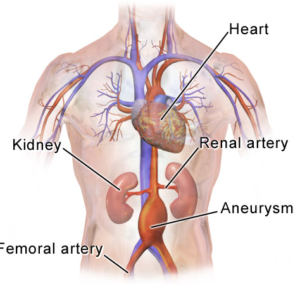
Your doctor will want your small abdominal aortic aneurysm to be followed with a watchful-waiting approach: serial imaging to see if the bulge is getting bigger.
This means imaging at fixed intervals to track any increase in size of the vessel dilation.
But how often should this occur? This depends on the size of the bulge and its growth rate over time.
The smallest abdominal aortic aneurysms often do not get significantly bigger over a course of many years.
But this doesn’t mean a small AAA shouldn’t be imaged with regular intervals of time in between.
Serial imaging is crucial. The survival rate of an abdominal aortic aneurysm rupture is about 20 percent.
Risk Factors
- Smoking
- High blood pressure
- Family history
- Being male and over 70
- Women are by no means immune to an abdomincal aortic aneurysm, and a large study showed that for women, high blood pressure was the leading risk factor,
Though most of these bulges grow at a slow rate, the rate varies from one patient to the next.
Though there’s no one-size-fits-all standard for time intervals between surveillance, there are general guidelines.
Time Intervals for Following an Abdominal Aortic Aneurysm
“Abdominal aortic aneurysms (AAA), defined as ≥ 1.5x the patient’s normal abdominal aortic diameter, should begin to be followed once they have reached 2.5 cm in diameter,” says Brett Mollard, MD, a board certified diagnostic radiologist who specializes in abdominal imaging and nuclear medicine.
“Recommended follow-up frequency is dependent on aneurysm size, with larger aneurysms requiring more frequent follow-up, as they typically have faster rates of growth and higher rates of rupture compared to smaller aneurysms.
“For example, aneurysms in the 2.5-2.9 cm range should be followed at either five year (Journal of the American College of Radiology) or 10 year intervals (The Society for Vascular Surgery); while aneurysms in the 4.0-4.4 cm range should be followed in one year intervals; and aneurysms greater than 5.5 cm in diameter or rapidly enlarging (≥ 5 mm in six months) should typically be treated.”
Conclusions
Cost effectiveness of following an abdominal aortic aneurysm needs to be assessed, as well as different types of surveillance policies.
Reducing imaging frequency would cut surveillance costs, yet also increase patient anxiety and rupture rates. In turn, costs related to emergency surgery would rise.

 Brett Mollard, MD
Brett Mollard, MD







































